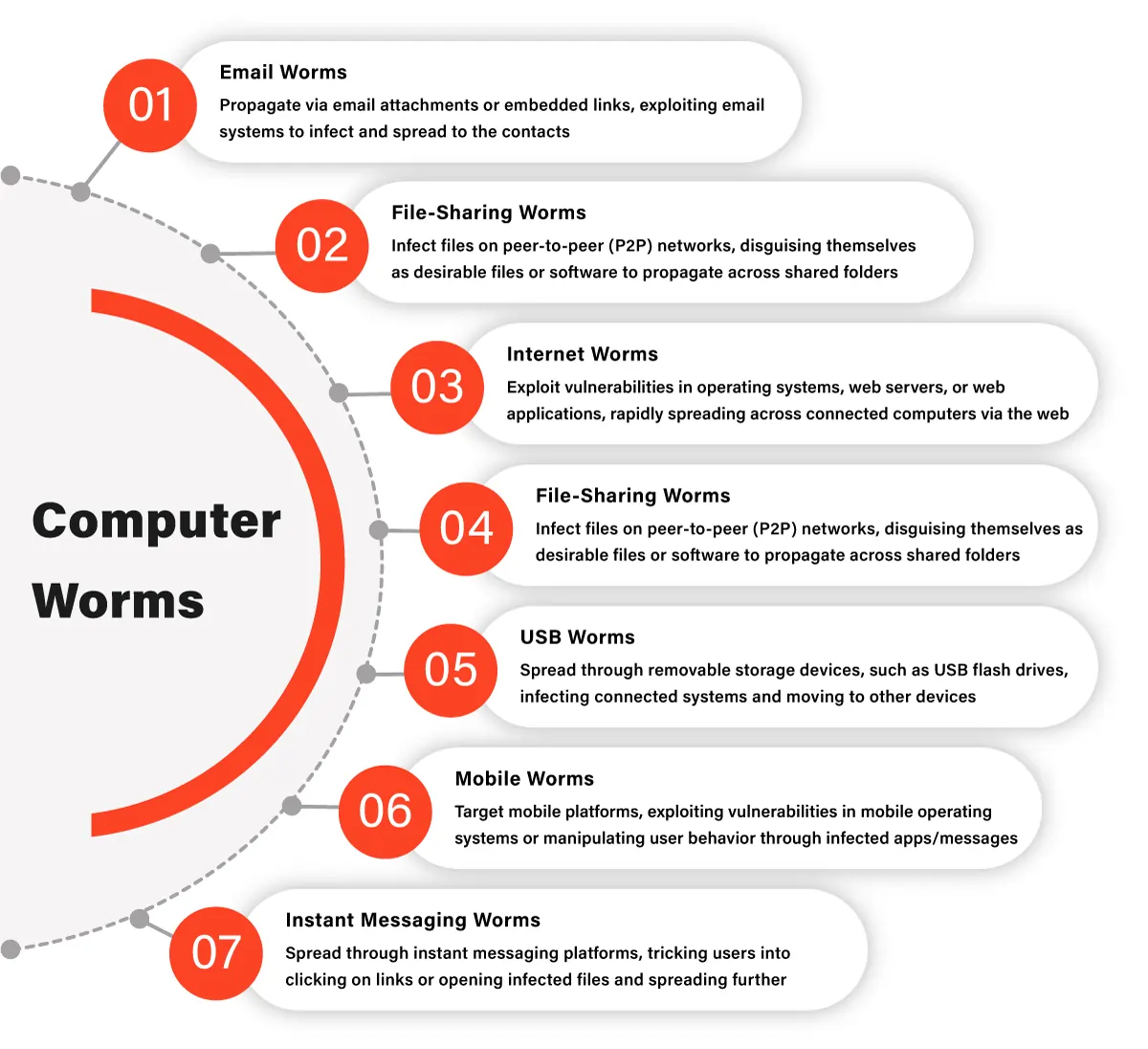Computer worms have emerged as a prominent and destructive force in the expansive realm of cybersecurity threats. These programmes have caused billions of pounds in damages and wreaked havoc on individuals, businesses, and governments. Grasping the nature of computer worms and their modus operandi is crucial for safeguarding ourselves and our digital assets.
In this all-encompassing guide, we will delve into the world of worms in computers, exploring their characteristics, how they infect systems, their various types, the methods by which they spread, their mechanisms of operation, and the measures we can take to protect against them.
Definitions of a Computer Worm
A computer worm is a type of malware that replicates itself and spreads autonomously without human intervention. Unlike computer viruses that require a host file to attach themselves to, worms can function as standalone programmes. This self-replication ability makes them particularly dangerous, as they can rapidly infect many systems, causing widespread damage.
A computer worm is a self-replicating program that can spread from one computer to another through various means.

It is designed to exploit vulnerabilities in computer systems and networks, allowing it to infect and compromise targeted machines.
Worms differ from computer viruses because they do not need a host file to propagate. They can operate independently and often have specific payloads or actions they perform once they infiltrate a system.
How Does a Computer Worm Infect Systems?
Computer worms utilise several methods to infect systems and networks. One common avenue of infection is through email attachments or links. Unsuspecting users may unknowingly open an infected attachment or click on a malicious link, thereby activating the worm. Once inside a system, the worm can spread to other devices within the same local area network (LAN) or across the internet.
Another method utilised by worms is through file sharing. Worms can disguise themselves as harmless media files or software programmes and spread them through peer-to-peer networks or file-sharing platforms. This method exploits users’ trust in shared content, leading them to unknowingly download and execute the malicious programme.
Types of Computer Worms
Computer worms come in various forms, each with its own unique characteristics and methods of propagation. Here are some common types of computer worms:

How Computer Worms Spread
Computer worms employ several techniques to spread from one system to another. Once inside an infected computer, a worm can scan the local network or the internet for vulnerable devices. It seeks out security weaknesses, such as unpatched software or default passwords, to gain unauthorised access. The worm then exploits these vulnerabilities to infiltrate the target system, where it can further propagate.
The ability of worms to spread rapidly is facilitated by their autonomous nature. Unlike other malware, worms can initiate self-replication and propagate without user interaction. This automation allows them to infect multiple systems within a short period, creating a domino effect of infections.
How Computer Worms Work
Once a computer worm successfully infects a system, it can carry out various malicious activities. These activities may include:
Replication: The worm creates copies of itself to spread to other vulnerable systems. It often does this by exploiting security vulnerabilities or using social engineering techniques to deceive users into executing the malicious programme.
Network Propagation: Worms can scan the local network or the internet for vulnerable systems to infect. They use techniques such as port scanning and exploiting known vulnerabilities to gain unauthorised access to targeted devices.
Payload Execution: Worms may have specific payloads or actions they perform once they infiltrate a system. These can include deleting files, encrypting files and demanding ransom, launching Distributed Denial of Service (DDoS) attacks, or installing backdoors for future unauthorised access.
Botnet Formation: Some worms are designed to transform infected systems into botnets. Botnets are networks of compromised devices controlled by a central command-and-control server. These botnets can be used for various malicious activities, such as launching coordinated attacks or sending spam emails.
Stealth and Persistence: Worms often attempt to evade detection by employing stealth techniques. They may hide within system files, use rootkit technologies to conceal their presence or disable security software to maintain persistence on the infected machine.
Protecting Against Computer Worms
Given the destructive potential of computer worms, it is essential to take proactive measures to protect against them. Here are some key steps you can take:
Keep Software Updated
Regularly update your operating system, applications, and security software to ensure that you have the latest patches and protection against known vulnerabilities.

Use Strong and Unique Passwords
Employ strong, complex passwords for all your accounts and avoid using the same password across multiple platforms. Consider using a password manager to securely store and manage your passwords.
Exercise Caution with Email Attachments and Links
Be vigilant when opening email attachments or clicking on links, especially if they come from unknown or suspicious sources. Scan attachments with an up-to-date antivirus programme before opening them.
Enable Firewall and Antivirus Protection
Activate a firewall to monitor incoming and outgoing network traffic and use reputable antivirus software to detect and remove malicious programmes.
Practice Safe File Sharing
Be cautious when downloading files from file-sharing networks. Verify the authenticity of the source, scan files for malware before execution, and use reputable platforms that implement security measures.
Educate Yourself and Stay Informed
Stay updated on the latest cybersecurity threats and best practices. Educate yourself about common social engineering techniques used by attackers and exercise caution while interacting with digital content.
Regularly Backup Your Data
Create backups of important files and ensure they are stored securely. In the event of a worm infection or any other data loss incident, backups can help restore your information.
By implementing these measures and maintaining good cybersecurity hygiene, you can significantly reduce the risk of falling victim to computer worms and other malware.
Computer worms pose a significant threat in today’s interconnected digital landscape. Their ability to self-replicate and spread autonomously makes them highly destructive and challenging to combat. By understanding their nature, methods of infection, propagation, and operation, we can take proactive steps to protect ourselves and our digital systems.
Regularly updating software, exercising caution with email attachments and links, and implementing strong security measures are essential in mitigating the risks posed by computer worms. By staying informed and adopting a proactive approach to cybersecurity, we can navigate the digital world with greater confidence and safety.
Frequently Asked Questions
What is a computer worm?
A computer worm is a type of malware that can replicate itself and spread from one computer to another without any human intervention. Unlike viruses, worms do not require a host file to attach themselves to and can operate independently.
What damage can computer worms cause?
Computer worms can cause significant damage to infected systems and networks. They can delete files, encrypt files and demand ransom, launch DDoS attacks, install backdoors for unauthorised access, or transform infected machines into botnets. The financial consequences of worm attacks can reach billions of pounds in damages.
What is a computer worm, and how is it different from a computer virus?
A computer worm is a type of malicious software that can replicate itself and spread independently from one computer to another. Unlike viruses, worms do not require a host file to attach themselves to. They can operate as standalone programmes and spread through various means, including networks and the internet.
How can I protect my computer against computer worms?
To protect your computer against worms, it’s important to follow good cybersecurity practices. Keep your operating system, applications, and security software up to date with the latest patches and updates. Use strong and unique passwords, enable firewalls, and install reputable antivirus software. Be cautious when opening email attachments or clicking on links from unknown or suspicious sources.
Can computer worms be removed from an infected computer?
Yes, it is possible to remove computer worms from an infected computer. You should use reputable antivirus or anti-malware software to scan your system and remove the malicious programme. It’s crucial to keep your antivirus software up to date and perform regular system scans. In some cases, advanced or persistent worms may require specialised removal tools or the assistance of cybersecurity professionals.
"*" indicates required fields
